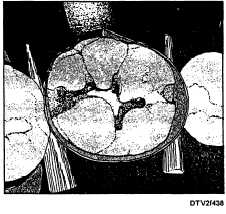Placement of Restorative Materials After the cavity preparation is completed, your attention as the assistant is especially critical. You must rapidly anticipate each step in the procedure to have the necessary material ready at the proper time. You must prepare and pass restorative materials, mix them at the right time, and follow the manufacturer's instructions. More instruments are needed to place the restoration than to prepare the tooth; therefore, more instrument transfers are necessary and occur more rapidly than in cavity preparation. Once the restorative materials have been placed in the oral cavity, the dentist then begins to finish the restoration.
CAVITY LINERS AND BASES.
- Most dentists use some type of cavity liner or base in almost all cavity preparations. They are used primarily to protect the pulp and to aid the pulp in recovering from irritation resulting from cavity preparation. Liners and bases are placed when the cavity preparation is completed, just before insertion of the restorative material.
Glass ionomer cements and dentin bonding agents are used primarily to seal the dentin and protect the pulp from bacterial invasion. Calcium hydroxide can be used in extremely deep areas as an antibacterial agent and/or as a pulp capping material.
Most bases are applied best when the assistant wipes the instrument clean between each small application. You will hold a gauze sponge in the transfer zone and quickly wipe the end of the instrument as the dentist moves toward the base mix. If the dentist inadvertently gets the base on the enamel walls of the cavity preparation, you will pass an instrument for removal of the material.
Cavity varnish is a liner used to seal the dentinal tubules to help prevent microleakage and is placed in a cavity to receive amalgam alloy after any bases have been placed. Cavity varnish is being used less and less with amalgam restorations, and dentin bonding agents are replacing cavity varnish as the liner of choice. Cavity varnish has an organic solvent of ether or chloroform that quickly evaporates, leaving the resin as a thin film over the preparation. This varnish should be slightly thicker than water. If it becomes very thick, discard it. Cavity varnish is not used with composites since the varnish retards the set of composites and interferes with the bonding of composites.
A small cotton pellet held by cotton forceps is dipped into the varnish just enough to wet the pellet. The cavity varnish is applied to the pulpal area, walls of the cavity preparation, and onto the edge of the margins of the preparation. Any excess varnish can be removed from the enamel with a fresh cotton pellet. A second application of cavity varnish is placed over the first to thoroughly coat the surfaces of the dentin and fill any voids from bubbles created when the first application dries. After liners and bases are placed into the cavity preparation, the tooth may be restored with materials, such as amalgam, composite resin, or glass ionomer.
AMALGAM RESTORATIONS.
- Amalgam is used as a restorative material on the surfaces of both permanent and primary teeth. Amalgam also is aesthetically acceptable for distal restorations of the cuspid when the restoration is not readily visible. Amalgam can also be used to prepare a sound base for a tooth before the preparation of a full artificial crown. This is commonly referred to as an amalgam buildup.
When multiple surfaces of the tooth are removed during the cavity preparation, a matrix is required to approximate the original wall and hold the restorative material in proper form and position until it sets. During the final stages of the cavity preparation, if not sooner, you should acknowledge the need for the matrix band and assemble it. While the liner and base materials set, the dentist places the assembled matrix band and retainer around the tooth, along with wedges if needed. Figure 4-38 illustrates a properly contoured and wedged matrix band.
While the dentist makes the final adjustments to the matrix, you will need to ensure the precapsulated amalgam is placed securely in the amalgamator and ready to triturate (mix). The operation and maintenance of the amalgamator is discussed in chapter 11, Volume 1, under Dental Equipment. Wait for a signal from the dentist to begin mixing the

Figure 4-38. - Properly contoured and wedged matrix band.
Continue Reading